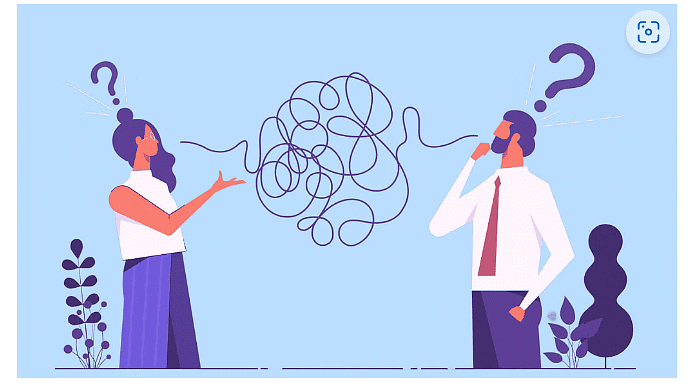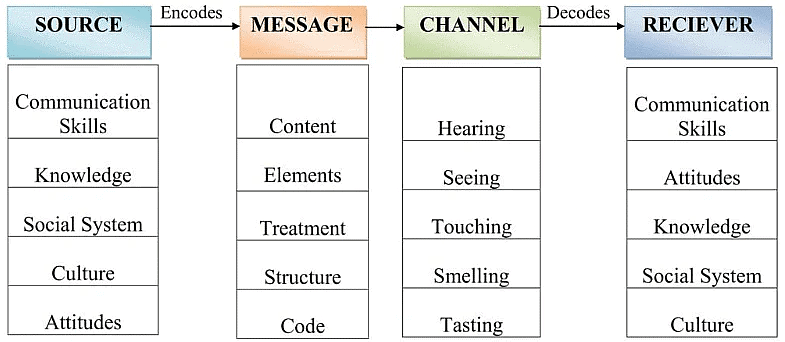Linear Model - Communication Notes
| Table of contents |

|
| Communication Models |

|
| 1. Lasswell’s model |

|
| 2. Aristotle’s Model |

|
| 3. Shannon Weaver Model |

|
| 4. Berlo’s S-M-C-R Model |

|
Communication Models
Communication Models
Communication Models are conceptual models used to explain the human communication process.

In this section, you will learn about four models of communication:
- Lasswell’s model
- Aristotle’s Model
- Shannon Weaver Model
- Berlo’s S-M-C-R Model
Linear Model of Communication
It is a simple one way communication model. The message flows in a straight line from sender to the receiver. There is no concept of feedback. The only task that a receiver does here is to receive the message. Four models that follow linear model of communication are:
1. Lasswell’s model
- Lasswell’s communication model was developed by communication theorist Harold D. Lasswell in 1948. Lasswell’s model of communication (also known as action model or linear model or one way model of communication) is regarded as one the most influential communication models.Harold Dwight Lasswell, states that a convenient way to describe an act of communication is to answer the following questions:
- Who: the person who formulates the message
- What: the content of the message
- Channel: the medium by which the message is being communicated
- Whom: the person or persons who receive the message
- Effect: the outcome of the message.

Advantages
- It is Easy and Simple
- It suits for almost all types of communication
- The concept of effect
Disadvantages
- Feedback not mentioned
- Noise not mentioned
- Linear Model
2. Aristotle’s Model
Aristotle developed a linear model of communication for oral communication known as Aristotle’s Model of Communication. This is considered as the first model of communication and was proposed before 300 B.C. It is also the most widely accepted among all communication models.
Aristotle Model is mainly focused on speaker and speech. It can be broadly divided into 5 primary elements:
- Speaker
- Speech
- Occasion
- Audience
- Effect

The Aristotle’s communication model is a speaker centered model as the speaker has the most important role in it and is the only one active. His words should influence in audience mind and persuade their thoughts towards him. The role of the audience is passive, influenced by the speech. This makes the communication process one way, from speaker to receiver.
3. Shannon Weaver Model
In 1948, Shannon was an American mathematician, Electronic engineer and Weaver was an American scientist both of them join together to write an article in Bell System Technical Journal‖ called “A Mathematical Theory of Communication” and also called as Shannon Weaver model of communication .According to the Shannon-Weaver Model, communication includes the following concepts: sender, encoder, channel, decoder, receiver and feedback. Furthermore, there is also concept of noise included in the model.
Elements of Model
- Sender(Information Source): The originator of message or the information source selects desire message.
- Encoder(Transmitter): The transmitter which converts the message into signals.
- Channel: Channel is the medium used to send message.
- Decoder (Receiver): Decoder is the machine used to convert signals or binary data into message or the receiver who translates the message from signals.
- Receiver (Destination): Receiver is the person who gets the message or the place where the message must reach. The receiver provides feedback according to the message.
- Noise: Noise is the physical disturbances like environment, people, etc. which does not let the message get to the receiver as what is sent.

Advantages
- Concept of noise helps in making the communication effective by removing the noise or problem causing noise.
- This model takes communication as a two way process. It makes the model applicable in general communication.
- Communication is taken as quantifiable in Shannon Weaver model.
Disadvantages
- Feedback is taken as less important in comparison to the messages sent by the sender.
- The model is taken by some critics as a “misleading misrepresentation of the nature of human communication” as human communication is not mathematical in nature.
- The Shannon-Weaver model, by its very nature, encounters some difficulty when applied to human communication. Its origin as a model to be applied to telecommunication, rather than to interpersonal human communication, limits its application due to the linear, unidirectional makeup.
4. Berlo’s S-M-C-R Model
While the Aristotle model of communication puts the speaker in the central position and suggests that the speaker is the one who drives the entire communication, the Berlo’s model of communication takes into account the emotional aspect of the message.Berlo’s Model has mainly, four components to describe the communication process. They are sender, message, channel and receiver. Each of the component is affected by many factors. Berlo’s model of communication operates on the SMCR model.
 In the SMCR model:
In the SMCR model:
S– Stands for Source
Sender is the source of the message or the person who originates the message. The person or source sends the message to the receiver. The following are the factor related to sender and is also the same in the case of receiver:
- Communication Skills: It is the individual’s skill to communicate i.e. ability to read, write, speak, listen etc. If the sender has good communication skills, the message will be communicated better than if the sender’s communication skills are not good. Similarly, if the receiver can not grasp the message, then the communication will not be effective. Communication skills include the skills to speak, present, read, write, listening, etc.
- Attitude: The attitude of the sender and the receiver creates the effect of the message. The person’s attitude towards self, the receiver and the environment changes the meaning and effect of the message.
- Knowledge: Familiarity with the subject of the message makes the communicated message have its effect more. Knowledge on the subject matter makes the communicator send the message effectively.
- Social Systems: Values, beliefs, laws, rules, religion and many other social factors affect the sender’s way of communicating the message. It creates difference in the generation of message. Place and situation also fall under social systems.
- Culture: Cultural differences make messages different. A person from one culture might find something offensive which is very much accepted in another culture.
M – Message
A message is the substance that is being sent by the sender to the receiver. It might be in the form of voice, audio, text, video or other media. The key factors affecting the message are
- Content: A thought has to be put into words and content has to be prepared. Content is actually the matter or the script of the conversation. It is in simpler words, the backbone of any communication.
- Elements: Elements are the non verbal things that tag along with the content like gestures, postures, facial expressions, body signs, language, etc.
- Treatment: Treatment is the way in which the message is conveyed to the receiver. Treatment also effects the feedback of the receiver.
- Structure: A message cannot be expressed in one go. It has to be properly structured in order to convey the message in the most desired form.
Code
Code is the form in which the message is sent. It might be in the form of language, text, video, etc.
- C – Channel: Channel actually refers to the medium how the information flows from the sender to the receiver. In mass communication and other forms of communication, technical machines might be used as a channel like telephone, internet, etc. But in general communication, all the five senses are the channels which help human beings to communicate with each
- Hearing- We receive the message through hearing.
- Seeing- We perceive through seeing. We also get non-verbal messages by seeing.
- Touching- Many of the non-verbal communication happens from touching like holding hands.
- Smelling- We collect information from smelling.
- Tasting- Taste also provides the information to be sent as a message.
R – Receiver
Receiver is the person who gets the message sent in the process. This model believes that the thinking pattern and all other factors mentioned above must be in sync to that of the sender for the communication to be effective. The message might not have the same effect as intended if the receiver and sender are not similar. The receiver must also have a very good listening skill. Other factors are similar to that of the sender.
- Communication skills
- Attitudes
- Knowledge
- Social Systems
- Culture
Criticism
- There is no concept of feedback, so the effect is not considered.
- The model does not mention about barriers to communication. There is no room for noise.
- It is a linear model of communication, there is no two way communication.
- Main drawback of the model is that the model omits the usage of sixth sense as a channel which is actually a gift to the human beings (thinking, understanding, analyzing etc).
- Both of the people must be similar according to all the factors mentioned above.
|
5 videos|18 docs|5 tests
|
FAQs on Linear Model - Communication Notes
| 1. What are the different communication models mentioned in the article? |  |
| 2. What is the significance of the linear model in communication? |  |
| 3. Who proposed the Shannon Weaver Model of communication? |  |
| 4. How does Berlo’s S-M-C-R Model differ from other communication models mentioned in the article? |  |
| 5. How does Aristotle’s Model of communication differ from the other models mentioned in the article? |  |


















